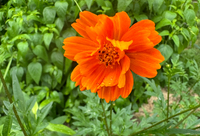
Delicious Blossoms

The list of edible flowers goes beyond the classic nasturtiums and marigolds of the potager.
Just like the peppery nasturtiums, the pretty blue stars of borage, with their lemon-cucumber flavor, are perfect for salads.
Lavender buds are the key ingredient in herbs de Provence and can be used to make aromatic butters and fragrant honey infusions.
I can't bring up the south of France without mentioning its beloved traditional confection, the candied violets.
Rose petals and rose water are added to sweet pastries and savory dishes alike, to impart delightful Mediterranean flavor.
If you have the chance, don't pass up the chance to try black locust flower crepes: they are a rare delicacy.
Finally, all the aromatic herbs used in cooking have beautiful and delicious flowers. The latter can be added to salads for a touch of style, or used the same way as the leaves.

The Mighty Tomatoes

There are so many tomato varieties I don't even know where to start. Their bounty comes in every size, shape and color, from red and orange cherry and grape clusters, to pear shaped yellow fruit.
For the goth landscape, black and deep purple varieties like Black Beauty, Black Krim, Purple Russian, and Cherokee are available.
A vibrant rainbow awaits whimsical garden enthusiasts, featuring every hue but red: Sungold and Persimmon bring cheery oranges, Green Zebras showcase chartreuse stripes, Pink Girl and Pink Pounder turn out candy colors, Yellow Pear and Lemon Drop ripen to bright yellows, and Burmese Sours turn up the heat with fiery shades of pumpkin.
Great White and White Beauty's fruits amaze, gleaming ethereal from under dark foliage, looking like ivory carvings.
If you prefer the classic reds, you can't go wrong with traditional tomato varieties such as Early Girl, Better Boy, or Roma, or heirlooms like Brandywine, Old German, Beefsteak, or Mortgage Lifter, all of which are tried and true and never disappoint.
Last, my personal favorite, Supersweet100 is a sweet and highly productive cherry tomato hybrid that I love so much I plant every year.
